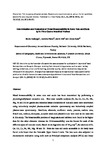Determination and evaluation of element bioaccessibility in some nuts and seeds by in-vitro gastro-intestinal method
| dc.contributor.author | Kafaoglu, B | |
| dc.contributor.author | EKİM DERTLİ, Samiye | |
| dc.contributor.author | Hill, Stephen | |
| dc.contributor.author | Kara, D | |
| dc.date.accessioned | 2016-03-30T14:53:51Z | |
| dc.date.accessioned | 2016-06-08T14:38:26Z | |
| dc.date.available | 2016-03-30T14:53:51Z | |
| dc.date.available | 2016-06-08T14:38:26Z | |
| dc.date.issued | 2015-09-26 | |
| dc.identifier.issn | 0889-1575 | |
| dc.identifier.issn | 1096-0481 | |
| dc.identifier.uri | http://hdl.handle.net/10026.1/4858 | |
| dc.description.abstract |
Element bioaccessibility in some nuts and seeds has been determined by performing a physiologically based extraction test. Nine elements (B, Ca, Co, Cu, Fe, Mn, Mg, Ni and Zn) in gastric and intestinal phase extractions of nuts and seeds were determined using inductively coupled plasma-atomic emission spectrometry and inductively coupled plasma-mass spectrometry. Hazelnuts, almonds, sunflower seeds, peanuts, cashew nuts, Brazil nuts, walnuts, chickpeas, pumpkin seeds and pistachio nuts were used as the materials in this study. The bioaccessible portions of magnesium and calcium were higher than for the other elements whereas B bioaccessibility was the lowest for each of the different types of nuts and seeds. Based on an ingestion rate of 10 g day−1, the amounts of B, Ca, Co, Cu, Fe, Mn, Mg, Ni and Zn from the nuts and seeds accessible to the body were found to be lower than the Tolerable Upper Intake Levels. The data were also subjected to chemometric evaluation using tools such as Principal Component Analysis (PCA) and Linear Discriminant Analyses (LDA) in an attempt to classify the nuts and seeds according to these elements bioaccessibility and to find out which elements are more bioaccessible in gastric and intestinal ingestions. | |
| dc.format.extent | 58-65 | |
| dc.format.medium | Undetermined | |
| dc.language | en | |
| dc.language.iso | en | |
| dc.publisher | Elsevier BV | |
| dc.relation.replaces | http://hdl.handle.net/10026.1/4445 | |
| dc.relation.replaces | 10026.1/4445 | |
| dc.subject | Bioaccessibility | |
| dc.subject | Elements | |
| dc.subject | Food analysis | |
| dc.subject | Food composition | |
| dc.subject | Linear discriminant analyses | |
| dc.subject | Nuts and seeds | |
| dc.subject | Principal component analysis | |
| dc.title | Determination and evaluation of element bioaccessibility in some nuts and seeds by in-vitro gastro-intestinal method | |
| dc.type | journal-article | |
| dc.type | Journal Article | |
| plymouth.author-url | http://gateway.webofknowledge.com/gateway/Gateway.cgi?GWVersion=2&SrcApp=PARTNER_APP&SrcAuth=LinksAMR&KeyUT=WOS:000366536200008&DestLinkType=FullRecord&DestApp=ALL_WOS&UsrCustomerID=11bb513d99f797142bcfeffcc58ea008 | |
| plymouth.volume | 45 | |
| plymouth.publication-status | Published | |
| plymouth.journal | JOURNAL OF FOOD COMPOSITION AND ANALYSIS | |
| dc.identifier.doi | 10.1016/j.jfca.2015.09.011 | |
| plymouth.organisational-group | /Plymouth | |
| plymouth.organisational-group | /Plymouth/Faculty of Science and Engineering | |
| plymouth.organisational-group | /Plymouth/Research Groups | |
| plymouth.organisational-group | /Plymouth/Research Groups/Marine Institute | |
| plymouth.organisational-group | /Plymouth/Users by role | |
| dcterms.dateAccepted | 2015-09-22 | |
| dc.rights.embargodate | 2016-9-26 | |
| dc.identifier.eissn | 1096-0481 | |
| dc.rights.embargoperiod | Not known | |
| rioxxterms.versionofrecord | 10.1016/j.jfca.2015.09.011 | |
| rioxxterms.licenseref.uri | http://www.rioxx.net/licenses/all-rights-reserved | |
| rioxxterms.licenseref.startdate | 2015-09-26 | |
| rioxxterms.type | Journal Article/Review |


